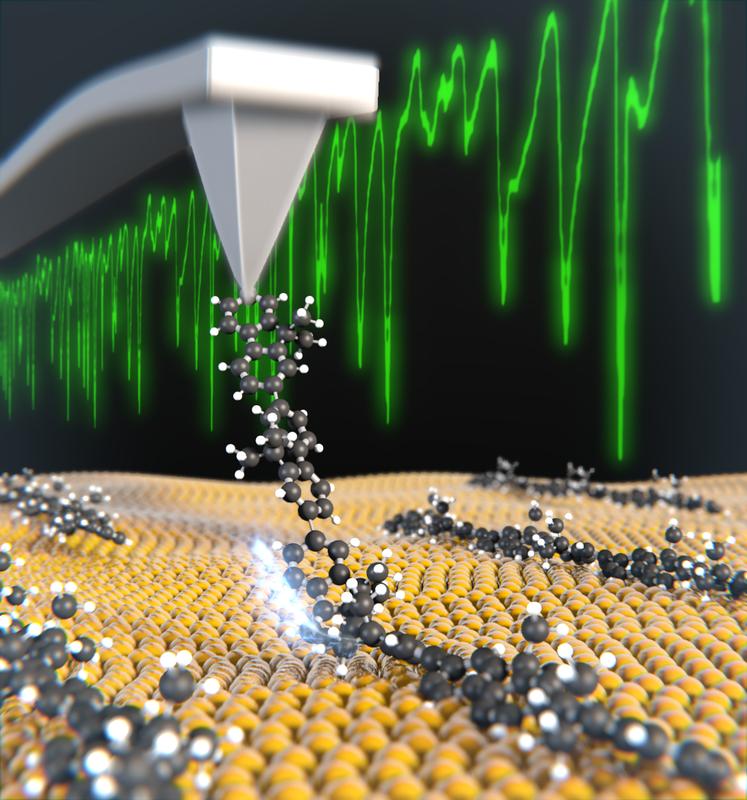Pulling Polymers Leads to New Insights into their Mechanical Behavior

The tip of an AFM pulling off a molecular chain vertically from a gold surface. (Illustration: Shigeki Kawai)
Atomic force microscopy is a method normally used for imaging matter with very high resolution. The sharp tip of the microscope is used to scan the surface line by line. The resolution is so high, that single atoms can be seen.
“This method is roughly equivalent to using the tip of the Matterhorn to scan the surface of a tennis ball”, says Prof. Ernst Meyer of the Department for Physics at the University of Basel. Due to an improved method, the scientists are now able to investigate the mechanical behavior of a single polymer being pulled off a surface.
Using the tip of the AFM, the researchers were able to pull single chains of molecules (polymers) off a gold surface. “The molecule-surface interaction during pulling is so weak that each chain link (molecular unit) detaches successively.
Thus, the whole chain can be pulled off almost vertically to the surface”, explains Meyer. By analyzing the observed oscillations, the researchers are able to make quantitative statements on the binding energy of each molecular unit.
Motion without friction
Furthermore, the experiments showed that the polymers could be pulled off with almost no lateral forces. This remarkable behavior of nearly frictionless motion was predicted by a theoretical model and has now been verified for molecules on a gold surface.
Previously, the mechanical behavior of single polymer during pulling from a surface had never been investigated with atomic-scale resolution. The findings and calculations of the research team now provide detailed insight into this process for the first time.
Such investigations are not only of interest for the field of physics, but also for biology and chemistry, since the method of pulling polymers from surfaces can also be applied to biological molecules. So far, valuable insights have been obtianed into the folding and unfolding of DNA and proteins. Chemical reactions of small biopolymer sub units or complex polymer chains under the influence of traction forces and catalytic nanoparticles could be investigated with this new method.
Original source
Shigeki Kawai, Matthias Koch, Enrico Gnecco, Ali Sadeghi, Rémy Pawlak, Thilo Glatzel, Jutta Schwarz, Stefan Goedecker, Stefan Hecht, Alexis Baratoff, Leonhard Grill and Ernst Meyer
Quantifying the atomic-level mechanics of single long physisorbed molecular chains
PNAS Early Edition | doi: 10.1073/pnas.1319938111
Further information
Prof. Ernst Meyer, University of Basel, Department of Physics, phone: +41 61 267 37 24, email: ernst.meyer@unibas.ch
http://unibas.ch/index.cfm?uuid=872F3068BB9FFB71DC9D3BF5D34565BC&type=search…
Media Contact
All latest news from the category: Physics and Astronomy
This area deals with the fundamental laws and building blocks of nature and how they interact, the properties and the behavior of matter, and research into space and time and their structures.
innovations-report provides in-depth reports and articles on subjects such as astrophysics, laser technologies, nuclear, quantum, particle and solid-state physics, nanotechnologies, planetary research and findings (Mars, Venus) and developments related to the Hubble Telescope.
Newest articles

Properties of new materials for microchips
… can now be measured well. Reseachers of Delft University of Technology demonstrated measuring performance properties of ultrathin silicon membranes. Making ever smaller and more powerful chips requires new ultrathin…

Floating solar’s potential
… to support sustainable development by addressing climate, water, and energy goals holistically. A new study published this week in Nature Energy raises the potential for floating solar photovoltaics (FPV)…

Skyrmions move at record speeds
… a step towards the computing of the future. An international research team led by scientists from the CNRS1 has discovered that the magnetic nanobubbles2 known as skyrmions can be…





















